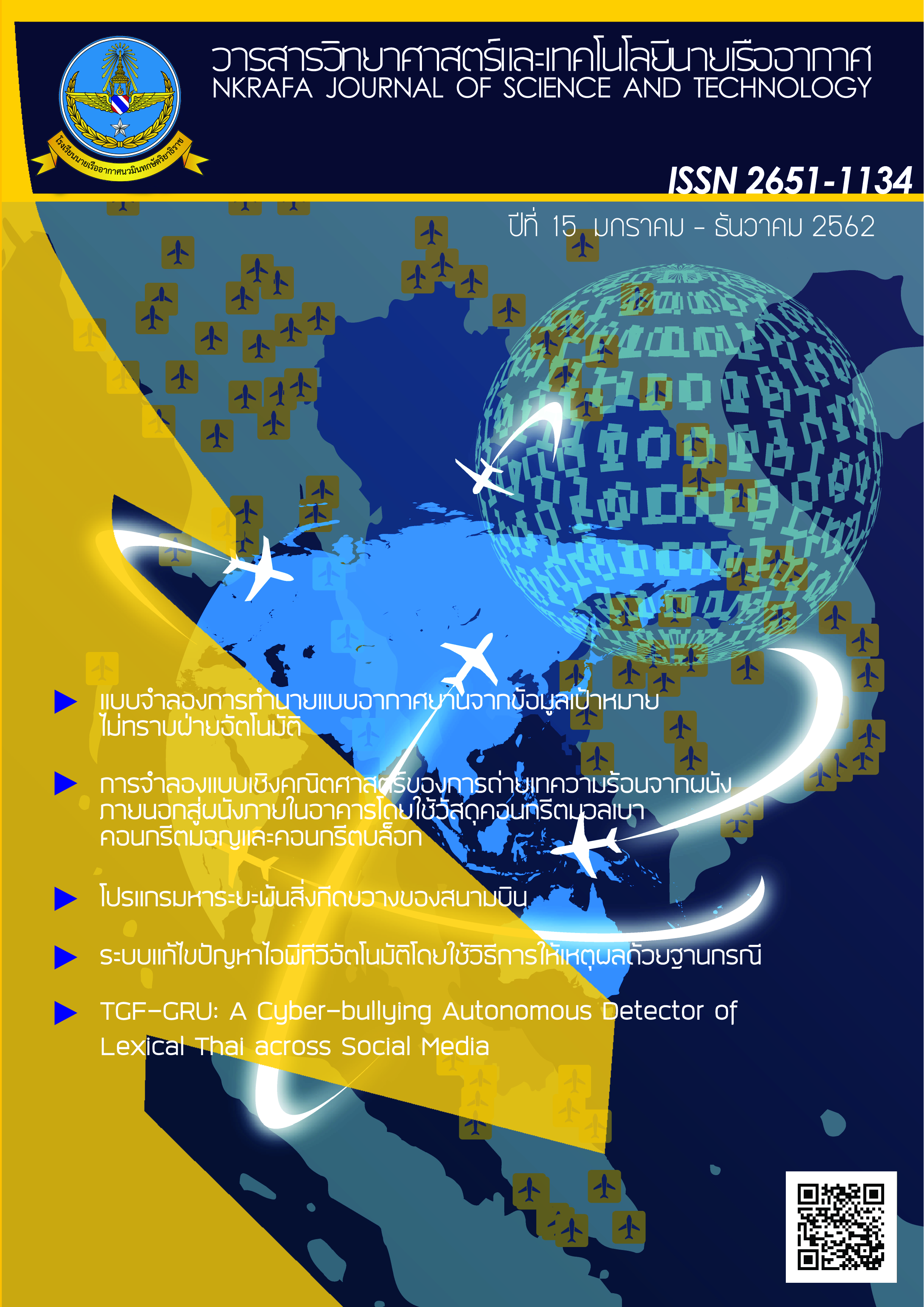Models for automatic aircraft type prediction
Main Article Content
Abstract
Air defense is one of the major missions of the Air Force. The first step is to find objects with speed which could pose a threat to national security by using radar. Basically, any object first detected by radar is determined to be an unknown target. In other word, it is a flying object which type and owner have not yet been identified. An accurate analysis of aircraft type and owner is an important factor for the decision on how the RTAF responds to the situation. For example, if it’s an opponent's combat aircraft, the RTAF will be able to intercept and alert aircraft units to defend the air base with appropriate tactics. At present, the analysis and identification of unknown targets are being handled by expert staffs with experience in operating and training with allied forces. The accuracy of the analysis depends on the capabilities of each officer. Training the staff to be competent and specialized in this field takes several years. The capability is also relevant to the aviation services that external agencies require, where the compensation is much higher. As a result, the resignation of the personnel of this group to sign contract with such agencies continuously occurs. To solve this issue, the researcher constructed a model for predicting unknown aircraft using the data from the air traffic analysis system of neighboring countries owned by Directorate of Intelligence by implementing data classification technique i.e. the Bayesian Network, SVM, and Decision Tree. The best result was a model derived from the Random Forest technique, because of its high accuracy in prediction. The researcher believes that this model can improve the decision-making process of the commanders more quickly and appropriately. The results of this research will be able to solve problems of expert personnel shortage and reduce the dependence on the expertise of specialized staffs in accordance with the concept of Smart Weapon Systems, which lead to the selection of the Smart Tactics of the RTAF.
Article Details
- Content and information in articles published in NKRAFA Journal of Science and Technology are comment and responsibility of authors of articles directly. Journal editorial do no need to agree or share any responsibility.
- NKRAFA Journal of Science and Technology Articles holds the copyright of the content, pictures, images etc. which published in it. If any person or agency require to reuse all or some part of articles, the permission must be obtained from the NKRAFA Journal of Science and Technology.
References
ศุภามณ จันทร์สกุล. (2561). เทคนิคเหมืองข้อมูลในการวิเคราะห์ข้อมูลทางการพยาบาล.วารสารวิชาการมหาวิทยาลัยอีสเทิร์นเอเชียฉบับวิทยาศาสตร์และเทคโนโลยี, 12(2): 83-96.
ภัทธิรา สุวรรณโค, นิศาชล จำนงศรี, จิติมนต์ อั่งสกุล. (2017). แบบจำลองการพยากรณ์ความเสี่ยงในการเกิดอุบัติเหตุทางถนนในเทศกาลปีใหม่ด้วยการทำเหมืองข้อมูล. Journal of Information Science and Technology, 7(2): 10-19.
สุรวัชร ศรีเปารยะ, สายชล สินสมบูรณ์ทอง. (2560). การเปรียบเทียบประสิทธิภาพวิธีการจำแนกกลุ่มการเป็นโรคไตเรื้อรังกรณีศึกษาโรงพยาบาลแห่งหนึ่งในประเทศอินเดีย. วารสารวิทยาศาสตร์และเทคโนโลยีสถาบันเทคโนโลยีพระจอมเกล้าเจ้าคุณทหารลาดกระบัง, 25(5) : 841-853
Y. Lv, Y. Duan, W. Kang, F.-Y. Wang. (2015). Traffic Flow Prediction With Big Data : A Deep Learning Approach. IEE Transactions on Intelligent Transportation Systems,16(2): 865-873.
บรรจบ ดลกุล, จารี ทองคำ, วาทินี สุขมาก. (2014). การสร้างแบบจำลองเพื่อพยากรณ์การเกิดแผลที่เท้าของผู้ป่วยโรคเบาหวานโดยใช้เทคนิคเหมืองข้อมูล. Journal of Science and Technology Mahasarakham University, 33(6): 703-710.
ปรเมษฐ์ ธันวานนท์, ชัยกร ยิ่งเสรี, วรพล พงษ์เพ็ชร์ และ ธนภัทร ฆังคะจิตร. (2017). การประยุกต์ใช้โมเดลการเรียนรู้แบบรวมกลุ่มเพื่อพยากรณ์แนวโน้มของราคาหลักทรัพย์ในตลาดหลักทรัพย์แห่งประเทศไทย. Journal of Information Science and Technology, 7(1): 12-21.
วิธวินท์ แสงมณี, วีระวุฑ รัตนเจริญเลิศ, ณัฏฐภพ โพธิรัชต์ และ เพียงฤทัย หนูสวัสดิ์. (2017). การสร้างโมเดลทำนายโอกาสการกลับมารักษาตัวซ้ำของผู้ป่วยโรคเบาหวานโดยใช้เทคนิคการทำเหมืองข้อมูล. The 5th ASEAN Undergraduate Conference in Computing (AUC2): 13-20.


